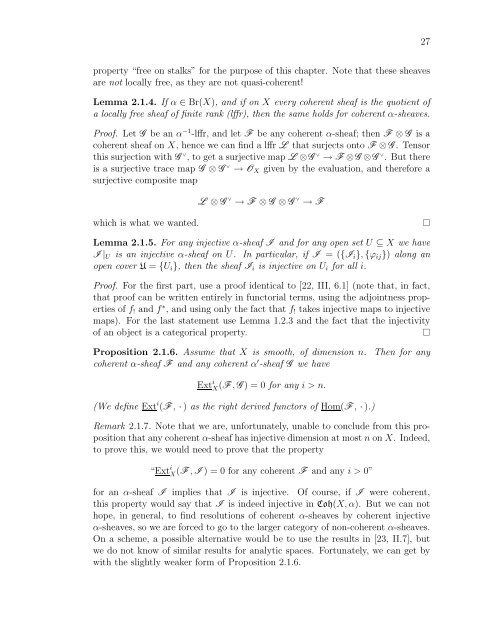derived categories of twisted sheaves on calabi-yau manifolds
derived categories of twisted sheaves on calabi-yau manifolds
derived categories of twisted sheaves on calabi-yau manifolds
Create successful ePaper yourself
Turn your PDF publications into a flip-book with our unique Google optimized e-Paper software.
property “free <strong>on</strong> stalks” for the purpose <str<strong>on</strong>g>of</str<strong>on</strong>g> this chapter. Note that these <str<strong>on</strong>g>sheaves</str<strong>on</strong>g><br />
are not locally free, as they are not quasi-coherent!<br />
Lemma 2.1.4. If α ∈ Br(X), and if <strong>on</strong> X every coherent sheaf is the quotient <str<strong>on</strong>g>of</str<strong>on</strong>g><br />
a locally free sheaf <str<strong>on</strong>g>of</str<strong>on</strong>g> finite rank (lffr), then the same holds for coherent α-<str<strong>on</strong>g>sheaves</str<strong>on</strong>g>.<br />
Pro<str<strong>on</strong>g>of</str<strong>on</strong>g>. Let G be an α −1 -lffr, and let F be any coherent α-sheaf; then F ⊗ G is a<br />
coherent sheaf <strong>on</strong> X, hence we can find a lffr L that surjects <strong>on</strong>to F ⊗ G . Tensor<br />
this surjecti<strong>on</strong> with G ∨ , to get a surjective map L ⊗G ∨ → F ⊗G ⊗G ∨ . But there<br />
is a surjective trace map G ⊗ G ∨ → OX given by the evaluati<strong>on</strong>, and therefore a<br />
surjective composite map<br />
which is what we wanted.<br />
L ⊗ G ∨ → F ⊗ G ⊗ G ∨ → F<br />
Lemma 2.1.5. For any injective α-sheaf I and for any open set U ⊆ X we have<br />
I |U is an injective α-sheaf <strong>on</strong> U. In particular, if I = ({Ii}, {ϕij}) al<strong>on</strong>g an<br />
open cover U = {Ui}, then the sheaf Ii is injective <strong>on</strong> Ui for all i.<br />
Pro<str<strong>on</strong>g>of</str<strong>on</strong>g>. For the first part, use a pro<str<strong>on</strong>g>of</str<strong>on</strong>g> identical to [22, III, 6.1] (note that, in fact,<br />
that pro<str<strong>on</strong>g>of</str<strong>on</strong>g> can be written entirely in functorial terms, using the adjointness properties<br />
<str<strong>on</strong>g>of</str<strong>on</strong>g> f! and f ∗ , and using <strong>on</strong>ly the fact that f! takes injective maps to injective<br />
maps). For the last statement use Lemma 1.2.3 and the fact that the injectivity<br />
<str<strong>on</strong>g>of</str<strong>on</strong>g> an object is a categorical property.<br />
Propositi<strong>on</strong> 2.1.6. Assume that X is smooth, <str<strong>on</strong>g>of</str<strong>on</strong>g> dimensi<strong>on</strong> n. Then for any<br />
coherent α-sheaf F and any coherent α ′ -sheaf G we have<br />
Ext i<br />
X(F , G ) = 0 for any i > n.<br />
(We define Ext i (F , · ) as the right <str<strong>on</strong>g>derived</str<strong>on</strong>g> functors <str<strong>on</strong>g>of</str<strong>on</strong>g> Hom(F , · ).)<br />
Remark 2.1.7. Note that we are, unfortunately, unable to c<strong>on</strong>clude from this propositi<strong>on</strong><br />
that any coherent α-sheaf has injective dimensi<strong>on</strong> at most n <strong>on</strong> X. Indeed,<br />
to prove this, we would need to prove that the property<br />
“Ext i X(F , I ) = 0 for any coherent F and any i > 0”<br />
for an α-sheaf I implies that I is injective. Of course, if I were coherent,<br />
this property would say that I is indeed injective in Coh(X, α). But we can not<br />
hope, in general, to find resoluti<strong>on</strong>s <str<strong>on</strong>g>of</str<strong>on</strong>g> coherent α-<str<strong>on</strong>g>sheaves</str<strong>on</strong>g> by coherent injective<br />
α-<str<strong>on</strong>g>sheaves</str<strong>on</strong>g>, so we are forced to go to the larger category <str<strong>on</strong>g>of</str<strong>on</strong>g> n<strong>on</strong>-coherent α-<str<strong>on</strong>g>sheaves</str<strong>on</strong>g>.<br />
On a scheme, a possible alternative would be to use the results in [23, II.7], but<br />
we do not know <str<strong>on</strong>g>of</str<strong>on</strong>g> similar results for analytic spaces. Fortunately, we can get by<br />
with the slightly weaker form <str<strong>on</strong>g>of</str<strong>on</strong>g> Propositi<strong>on</strong> 2.1.6.<br />
27
















